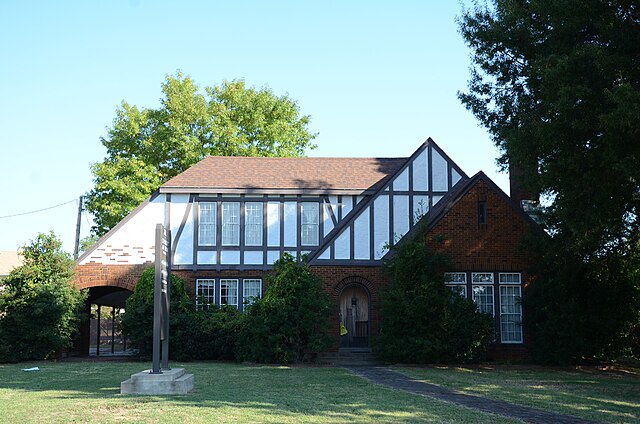Are you planning a trip to Searcy, Arkansas, or thinking about making this charming city your new home? Understanding the local weather patterns is crucial for making the most of your time in this beautiful part of the Natural State. Searcy’s weather tells a story of Southern hospitality mixed with the unpredictability that makes Arkansas weather so interesting.
Located in the heart of Arkansas, Searcy experiences a humid subtropical climate that brings hot, sticky summers and mild winters. But there’s so much more to the weather story here than just temperatures and rainfall. From springtime tornado seasons to the occasional winter ice storm, Searcy’s weather keeps residents and visitors on their toes year-round.
Understanding Searcy’s Geographic Location and Climate Zone
Where Searcy Sits on the Weather Map
Searcy sits pretty in White County, Arkansas, about 50 miles northeast of Little Rock. This strategic location puts the city right in the path of various weather systems that sweep across the southern United States. The city’s position at roughly 35.2°N latitude places it firmly in the humid subtropical zone, which means you can expect warm, humid summers and generally mild winters.
The geography around Searcy plays a huge role in shaping its weather patterns. Surrounded by the foothills of the Ozark Mountains to the north and relatively flat terrain to the south, the area acts like a funnel for weather systems moving through the region. This unique positioning means Searcy often experiences more dramatic weather changes than you might expect for a city its size.
Arkansas’s Humid Subtropical Climate Explained
What exactly does “humid subtropical” mean for your day-to-day life in Searcy? Think of it as nature’s way of saying, “Get ready for variety!” This climate classification means you’ll experience four distinct seasons, each with its own personality and quirks.
The humid part of the equation comes from the Gulf of Mexico, which sends moisture-laden air masses northward throughout much of the year. This creates the sticky, humid conditions that make Arkansas summers feel hotter than the thermometer suggests. The subtropical aspect means winters rarely get brutally cold, though don’t let that fool you into thinking you won’t need a good coat come January.
Seasonal Weather Patterns in Searcy, Arkansas

Spring Weather in Searcy (March-May)
Temperature Ranges and Rainfall
Spring in Searcy is like watching the world wake up from a long winter nap. March typically starts cool, with average highs in the mid-60s, but by May, you’re looking at comfortable temperatures in the upper 70s to low 80s. Night temperatures during spring range from the 40s in early March to the comfortable 60s by late May.
Rainfall during spring months averages around 4-5 inches per month, with April typically being the wettest. This abundant moisture combines with warming temperatures to create the perfect conditions for everything to turn green almost overnight. You’ll want to keep an umbrella handy during spring months, as afternoon and evening thunderstorms become increasingly common.
Severe Weather Season Begins
Here’s where spring in Searcy gets interesting – and potentially dangerous. The months of April and May mark the beginning of Arkansas’s severe weather season. The collision between warm, moist air from the Gulf and cool, dry air from the north creates perfect conditions for severe thunderstorms and tornadoes.
Don’t let this scare you away from enjoying spring in Searcy, but do take it seriously. Having a weather radio and knowing where your safe room is located isn’t just good advice – it’s essential for anyone living in or visiting the area during spring months.
Summer Heat and Humidity (June-August)
Peak Temperature Months
Summer in Searcy isn’t for the faint of heart when it comes to heat and humidity. July typically claims the title of hottest month, with average high temperatures climbing into the low 90s. But here’s the kicker – the humidity makes it feel much hotter. Heat index values frequently reach 100°F or higher during peak summer months.
Nighttime doesn’t offer as much relief as you might hope, with overnight lows during summer typically only dropping into the 70s. This means your air conditioning unit becomes your best friend from June through August. The combination of heat and humidity creates what locals affectionately call “Arkansas sauna conditions.”
Summer Storm Patterns
Summer thunderstorms in Searcy follow a fairly predictable pattern. Most develop during the late afternoon and early evening hours when heating from the sun reaches its peak. These storms can be intense but are usually brief, providing temporary relief from the heat and humidity.
The good news about summer storms is that they’re generally less likely to produce tornadoes than their spring counterparts. However, they can still pack a punch with heavy rain, lightning, and occasional hail. Flash flooding can become an issue during particularly heavy downpours, especially in low-lying areas around the city.
Fall Weather Transitions (September-November)
Comfortable Temperatures Return
Fall might just be the best time to experience Searcy weather. September still holds onto some summer heat, with highs in the 80s, but the humidity begins to decrease noticeably. By October, you’re looking at perfect weather with highs in the 70s and lows in the 50s – ideal conditions for outdoor activities and enjoying the changing foliage.
November brings the first taste of winter, with temperatures dropping into the 60s for highs and 40s for lows. The humidity continues to decrease, making even the cooler temperatures feel comfortable. This is when locals start to emerge from their air-conditioned hideaways and remember why they love living in Arkansas.
Hurricane Season Impact
While Searcy sits hundreds of miles from the Gulf Coast, hurricane season can still impact local weather. Tropical systems that make landfall along the Gulf Coast often track northward, bringing heavy rain and strong winds to the Searcy area. These events typically occur between August and October, with September being the peak month for tropical activity.
The remnants of hurricanes and tropical storms can actually provide beneficial rainfall to the area, helping to ease any drought conditions that may have developed during the hot summer months. However, they can also bring flooding and power outages, so it’s important to stay weather-aware during hurricane season.
Winter Weather in Searcy (December-February)
Mild Winter Characteristics
Compared to northern states, winter in Searcy is relatively mild. Average high temperatures during winter months range from the 40s to low 50s, while overnight lows typically drop into the 20s and 30s. Snow is possible but not common, with most winters seeing only a few light dustings rather than significant accumulations.
January is typically the coldest month, but even then, temperatures rarely stay below freezing for extended periods. This makes Searcy an attractive destination for those looking to escape harsher northern winters while still experiencing the change of seasons.
Ice Storm Potential
While snow might not be a major concern, ice storms are a different story entirely. Arkansas sits in what meteorologists call “ice storm alley,” and Searcy is right in the middle of it. Ice storms occur when warm air overrides a shallow layer of cold air at the surface, causing rain to freeze on contact with cold surfaces.
These events can be beautiful but dangerous, coating everything in a thick layer of ice. Power outages are common during ice storms, and travel becomes extremely hazardous. Most ice storms in the Searcy area occur between December and February, with January being the peak month for these events.
Current Weather Conditions and Forecasting
Where to Find Reliable Searcy Weather Updates
Staying informed about Searcy weather has never been easier, thanks to modern technology and dedicated local meteorologists. The National Weather Service office in North Little Rock provides official forecasts and warnings for the Searcy area. Their website and mobile apps offer detailed current conditions, hourly forecasts, and severe weather alerts.
Local television stations also provide excellent coverage of Searcy weather, with meteorologists who understand the unique characteristics of Arkansas climate. Many residents rely on weather apps like Weather Underground, AccuWeather, or the National Weather Service app for quick updates and radar imagery.
Understanding Weather Alerts and Warnings
Weather alerts and warnings in Arkansas follow a specific hierarchy that everyone should understand. Watches mean conditions are favorable for severe weather development, while warnings mean severe weather is imminent or occurring. For Searcy residents, the most common alerts include severe thunderstorm watches and warnings, tornado watches and warnings, and winter weather advisories.
The Emergency Alert System (EAS) will automatically notify you of life-threatening weather situations through your cell phone, radio, and television. Don’t ignore these alerts – they’re issued only when there’s an immediate threat to life and property in your specific area.
Extreme Weather Events in Searcy
Tornado Activity and Safety
Searcy sits in the heart of “Dixie Alley,” a region known for significant tornado activity. While not as famous as Oklahoma’s “Tornado Alley,” this area of Arkansas, Tennessee, Mississippi, and Alabama actually sees more violent tornadoes per square mile than anywhere else in the country.
The peak tornado season in Searcy runs from April through June, with May typically being the most active month. Most tornadoes occur during late afternoon and early evening hours when atmospheric instability reaches its peak. Having a severe weather plan isn’t optional in Searcy – it’s a necessity for anyone who lives in or visits the area.
Severe Thunderstorm Patterns
Severe thunderstorms in Searcy can produce damaging winds over 58 mph, hail larger than quarters, and dangerous lightning. These storms are most common during spring and early summer months but can occur any time conditions are right. The combination of heat, humidity, and atmospheric lift creates perfect conditions for explosive thunderstorm development.
Straight-line winds from severe thunderstorms can be just as dangerous as tornadoes, causing widespread tree damage and power outages. Hail is another significant threat, with stones larger than golf balls not uncommon during the most severe storms.
Ice Storm History and Preparation
Arkansas ice storms are legendary for their destructive power, and Searcy has experienced its share of these events. The ice storm of 2009 left hundreds of thousands without power across Arkansas, with some areas of Searcy experiencing outages lasting more than a week.
Preparing for ice storms means having alternative heating sources, plenty of food and water, and battery-powered or hand-crank radios for weather updates. Never use outdoor grills or generators inside your home, as carbon monoxide poisoning is a serious risk during power outages.
Monthly Weather Breakdown for Searcy

January Through June Weather Expectations
January in Searcy brings winter’s chill, with average highs around 48°F and lows near 28°F. February shows slight warming, with highs reaching the mid-50s. March marks the beginning of spring with highs in the mid-60s and the return of regular rainfall.
April brings beautiful spring weather but also increased severe weather potential. Highs reach the mid-70s while overnight lows settle into the comfortable 50s. May continues the warming trend with highs near 80°F and begins the transition toward summer humidity levels. June officially kicks off summer with highs in the upper 80s and the return of oppressive humidity.
July Through December Climate Patterns
July and August represent peak summer in Searcy, with high temperatures regularly reaching the low 90s and heat index values soaring over 100°F. September begins the gradual transition toward fall, though summer heat often lingers through the first half of the month.
October brings some of the most pleasant weather of the year, with highs in the 70s and low humidity levels. November continues the cooling trend with highs in the 60s and the first frost typically occurring by mid-month. December brings winter’s return with highs in the 50s and the potential for the season’s first ice storm.
Planning Your Visit: Best Weather Times
Outdoor Activities and Weather Considerations
If you’re planning outdoor activities in Searcy, timing is everything. Late spring (April-May) and fall (October-November) offer the most comfortable conditions for hiking, camping, and other outdoor pursuits. Summer months require early morning or late evening scheduling to avoid the oppressive heat and humidity.
Winter can be excellent for outdoor activities, but you need to be prepared for rapidly changing conditions. A sunny 60-degree day in February can quickly turn into a 30-degree ice storm, so always check the forecast before heading out.
Event Planning and Weather Factors
Planning an outdoor event in Searcy requires careful consideration of seasonal weather patterns. Spring events need backup indoor plans due to severe weather potential. Summer events should include shade, hydration stations, and heat illness prevention measures.
Fall offers the most reliable weather for outdoor events, though you should still have contingency plans for the occasional tropical system remnants. Winter events face the challenge of unpredictable ice storm potential, making indoor venues often the safer choice.
Climate Change Impact on Searcy Weather
Climate change is already affecting Searcy’s weather patterns in measurable ways. Summers are becoming hotter and more humid, with an increasing number of days reaching dangerous heat index levels. Extreme precipitation events are becoming more common, leading to increased flooding risks.
Winter weather patterns are also shifting, with ice storms potentially becoming more frequent as temperature profiles change. These changes require residents and visitors to stay more weather-aware than ever before and adapt their plans accordingly.
The frequency and intensity of severe weather events may also be changing, though the research is still ongoing. What’s clear is that having reliable weather information and emergency plans is becoming even more critical for anyone spending time in Searcy.
Conclusion
Searcy’s weather is a perfect reflection of Arkansas’s diverse and sometimes dramatic climate. From sweltering summer days that make you appreciate air conditioning to crisp fall mornings that remind you why you love the South, the weather here tells a story of seasonal variety and occasional extremes.
Understanding Searcy’s weather patterns isn’t just about knowing when to carry an umbrella or wear a jacket. It’s about respecting the power of nature and preparing for the unexpected. Whether you’re a long-time resident or planning your first visit, staying weather-aware and having proper emergency plans will help you make the most of your time in this beautiful Arkansas city.
The key to living with or visiting Searcy weather is flexibility and preparation. Embrace the variety, respect the extremes, and always keep one eye on the sky. After all, in a place where the weather can change as quickly as Arkansas hospitality can make you feel at home, being prepared for anything is just part of the charm.
Frequently Asked Questions
1. What is the best time of year to visit Searcy weather-wise?
October and November offer the most comfortable weather in Searcy, with mild temperatures, low humidity, and minimal severe weather threats. Spring (April-May) is also beautiful but comes with increased severe weather potential.
2. How often does Searcy experience tornadoes?
While Searcy is located in a tornado-prone region, actual tornado strikes on the city are relatively rare. However, the surrounding area experiences several tornado watches and warnings each spring, making weather preparedness essential.
3. What should I pack for a summer visit to Searcy?
Pack lightweight, breathable clothing, sunscreen, a good hat, and comfortable walking shoes. Don’t forget an umbrella for afternoon thunderstorms and layers for over-air-conditioned indoor spaces.
4. Are ice storms really that dangerous in Searcy?
Yes, ice storms pose significant risks in Searcy, including widespread power outages, dangerous driving conditions, and falling tree limbs. Having emergency supplies and alternative heating sources is crucial during winter months.
5. How accurate are weather forecasts for Searcy?
Modern weather forecasting is quite accurate for Searcy, especially for temperature and general precipitation. However, the timing and exact location of severe weather can still be challenging to predict more than a few hours in advance, which is why staying weather-aware is so important.

